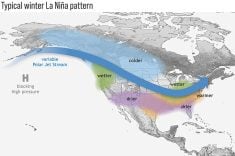SASKATOON – Wet weather in the U.S. midwest has dampened demand for Canadian potash fertilizer, says an industry official.
Don Boyle, president of the Saskatchewan Mining Association, said the disruption in spring seeding has translated into lower than expected sales south of the border so far this year.
“Certainly in the (U.S.) corn belt the spring expectations haven’t materialized,” said Boyle.
But that doesn’t mean the sales have been permanently lost, he added: “Because they’ve been economically doing very well, with excellent corn prices, they’ll put it on in the fall.”
Read Also

Canadian Food Inspection Agency extends chronic wasting disease control program consultation deadline
Date extended for consultation period of changes to CWD program
In some ways, problems in the U.S. have been a blessing for the industry because China has recently been buying huge quantities of potash. In March of 1994, China bought 500,000 tonnes from the export agency Canpotex, later picking up an option for 200,000 more. Then last November it purchased another 800,000 tonnes, with an option for 500,000 more. The full amount is slated for delivery by this summer.
Purchases of that magnitude have tested the industry’s productive capabilities, Boyle said. Even though the province’s 10 potash mines have been going “full blast,” inventories have been driven down to extremely low levels.
“It would have been tough to keep up with demand if a normal spring had developed,” he said.
While about 65 percent of Canada’s potash exports go to the U.S., China is a potentially huge market, with a booming economy and a growing interest in improving its agricultural productivity.
“Clearly they have seen the benefits of applying potash,” said Boyle, adding China’s balance of soil nutrients has been “way out of whack,” with excessive nitrogen and low potash.
But they’re tough bargainers and will look around the world for the cheapest suppliers, said Boyle. Other exporters include Jordan, Israel, East Germany, Spain and France.
“China is unbelievably difficult to predict,” he said.
Boyle was traveling across the province two weeks ago promoting mining awareness week. Mining has traditionally been number two behind agriculture in contributing to the pro-vince’s gross domestic product, although it has slipped into third place as a result of the boom in oil and gas.
The 40 member companies of the Saskatchewan Mining Association had sales of $1.7 billion in 1994, up from $1.3 billion the year before. Potash accounted for about $1.1 billion. The industry employs about 5,800 people directly, while another 12,000 work in related support industries.
Boyle said that compared to agriculture, mining has always been an “inconspicuous” industry considering its importance to the province’s economy.
“We’re trying to educate the public about it,” he said, adding the industry likes to say that “if you can’t grow it, you have to mine it.”














